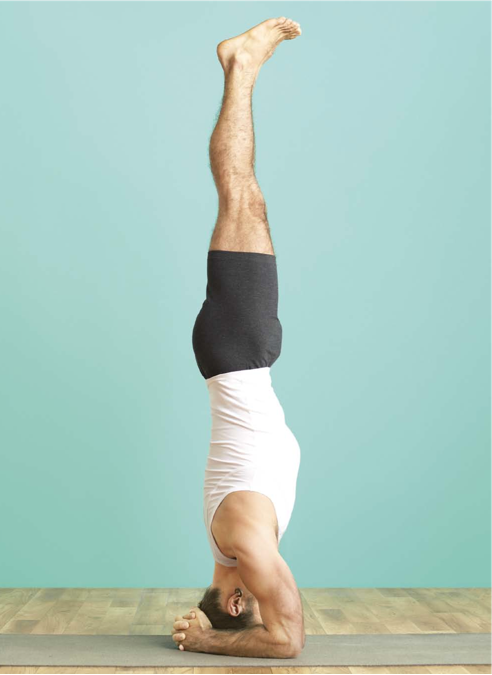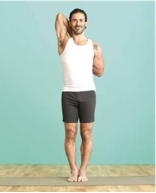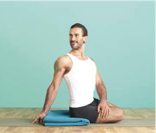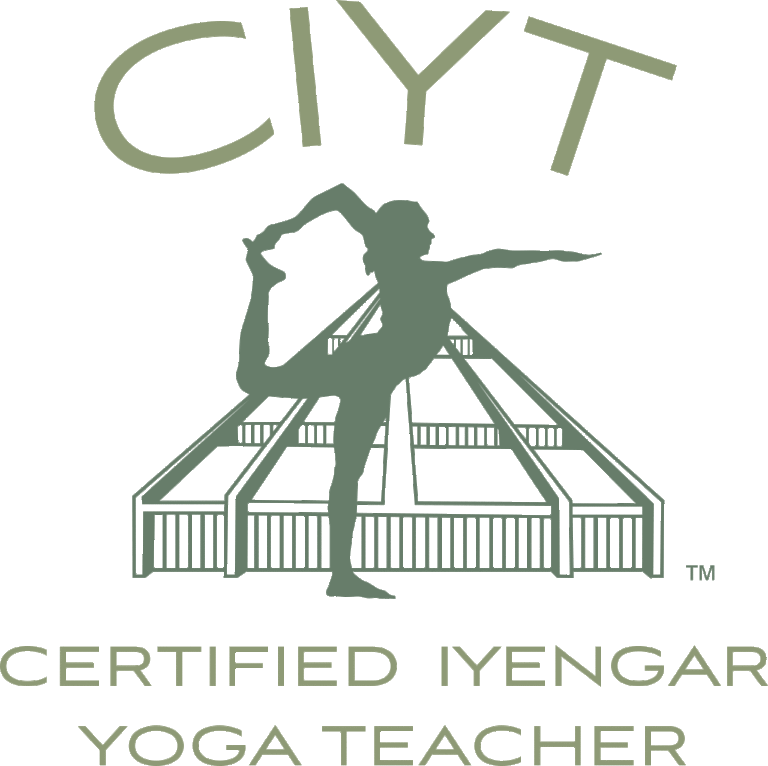
Sirsasana
One way to cultivate a strong, steady, and safe Headstand is to practice with an understanding of the three qualities or forces of nature, the gunas: sattva, rajas, and tamas. You can recognize the qualities of tamas as physical or mental heaviness, inertia, and immobility; rajas as effort, firmness, vibration, and action. Although the three gunas are always present in varying degrees, it’s common for tamas or rajas to take center stage, masking the clarity and luminosity of sattva. When tamas dominates your yoga practice, your body and mind will feel dull and lethargic. And when rajas is predominant, you may find yourself overworking and struggling through every pose.
As you begin to work with an understanding of the gunas in your practice, you’ll see how activity and effort help to pierce heaviness and immobility and begin to cultivate the luminous quality of sattva. Each pose, as well as your practice overall, becomes clear, and light, ultimately more sattvic. When this happens, you can safely increase the amount of time you spend in any pose, including Headstand.
In addition, the sattvic quality you cultivate in Headstand can help you navigate your moment-to-moment feelings, observations, and actions so that even with two feet on the ground, you feel steady, centered, and non-reactive.
Tadasana (Mountain Pose) with arms in Gomukhasana (Cow Face Pose)
Practicing Tadasana with Gomukhasana arms will teach extension and external rotation in the upper arm and active engagement in your legs. These actions will help you create a solid base and a feeling of lightness as you lift weight away from your neck and head in Headstand.
Stand with your feet together in Tadasana.
Move your shoulder blades toward the front body and rotate your biceps forward and your triceps back, externally rotating your upper arms. Take the outer corners of your shoulders back and release the tops of your trapezius muscles, near the base of the neck, down. Lift your right arm, extend from the outer armpit up to your elbow, then bend your right elbow placing your palm on your upper back.
Bend your left elbow and clasp your hands together behind you. If you can’t reach, hold a belt between your hands. Lift the shoulder slightly toward your ear and move the left shoulder blade in toward the spine and forward toward your chest, then roll the left outer shoulder back. An injection of effort is required to get a deeper opening in the shoulders and overcome the tamas that develops when the shoulder curl forward.
Maintain a steady and stable Tadasana as you lift the right outer arm from the armpit to the elbow and rotate from the outer elbow toward the inner elbow for up to a minute. Then release your arms and repeat on your left side. After you’ve taken both sides, stand in Tadasana and observe the openness in your shoulders and chest.
Bharadvajasana I (Bharadvaja’s Twist)
In Bharadvajasana, you’ll focus on opening the front of your shoulders and moving the upper back in toward your sternum. These actions will help your upper body support you in Sirsasana.
Sit on a folded blanket in Dandasana (Staff Pose). Bend your knees and take your feet beside your left hip with your left foot on top of the arch of the right foot. Keep your knees facing forward and your thighs together. Drop the left buttock and hip downward as you lift your chest.
Place your right hand behind you and your left hand to the outside of your right knee. On an inhalation, lift your chest; on an exhalation, turn to the right. If you find that you’re leaning back onto the right hand, elevate your right hand on a block.
Move your shoulder blades toward the front of your torso and broaden the top of your chest. Walk your right hand further back and around, closer to the left buttock. Now roll your outer right shoulder further back. Move the left back ribs forward, and on an exhalation, turn your chest from left to right turning your head to follow.
As your right shoulder moves back, move your right shoulder blade and the thoracic spine (the area between your shoulder blades) inward toward your chest to raise the sternum higher. Initiate the twist from movement in your upper back, an action that will keep your thoracic spine and back ribs from collapsing in Sirsasana.
Breathe smoothly letting go of unnecessary strain in the throat and trapezius muscles. Hold for up to a minute, then release back to center, and take the second side. The rajas that comes from the strong actions and movement in the upper body balanced with the steadiness in your hips and legs brings a dynamic and centered, sattv-ic quality to this twist.
Adho Mukha Svanasana (Downward-Facing Dog)
Lengthening the inner arms and biceps up from your elbows toward the shoulders in Down Dog while releasing your head downward will help you bring lightness and stability to your Headstand. You’ll work to create length in the neck by moving your shoulder blades and upper spine away from your head.
Come onto your hands and knees
Pull your inner shoulders and trapezius muscles (at the space between the shoulders and neck) away from your ears toward your hips. Move your shoulder blades and thoracic spine toward your chest. Allow the sides of your neck and backs of your ears to lengthen down and away from the upward-lifting action of your upper back. Relax your throat.
As you release your head and neck down, you may find that the shoulders move toward the ears and your neck tightens and shortens. Or if the head becomes too heavy, it pulls the shoulders and upper spine with it down toward the floor and tamas predominates. Make sure the lift through your inner arms, shoulders, and upper back equals the release of tension in the sides of your neck and throat so that you can find the harmony where the qualities of tamas and rajas meet.
If you’re able to hold Down Dog with firmness and attention, you can stay for two to three minutes. If you feel strained, hold for 20 seconds and then release into Adho Mukha Virasana (Child’s Pose), repeating these two poses a few times.
Prasarita Padottanasana (Wide-Legged Standing Forward Bend)
You’ll 
Extend your torso and fold forward, placing your fingertips on the floor underneath your shoulders. Straighten your arms, extend your sternum forward, and press your thighbones back. Pull your inner shoulders away from your neck and move the thoracic spine down toward your chest as you pull your chest forward between your arms.
Bend your elbows, walk your palms back in line with your feet on the floor, and lengthen your neck as you release the crown of your head to the floor. If your head doesn’t reach the floor, rest your head on a block. Your hands and head should form a tripod. If you have tight hamstrings and it is difficult to bend forward, continue to work with your arms straight.
Keep weight in your legs as you spread the soles of your feet evenly on the floor, keep your heels grounded, and pull the fronts and inner thighs up. Press your thighs back and broaden the backs of your legs. As in Adho Mukha Svanasana, release your head and neck downward without allowing the entire pose to collapse. Balance the vibrant quality in your legs with the quiet surrender in your head to find an equilibrium that enables you to remain in the pose, calm and alert for up to three minutes.
On an inhalation straighten your arms, lift your chest, and extend your chest forward. On an exhalation, place your hands on your hips. Then inhale and stand up, walk your feet in toward each other, and return to Tadasana.
Salamba Sirsasana (Supported Headstand)
Remember, the importance of a safe balanced practice is far more important than the duration of the pose. If this is your first time coming into Headstand or if you know you’re not able to balance in the middle of the room, set up near a wall or in a corner with your hands close to the wall.
Come onto your hands and knees, place your forearms on the floor with elbows shoulder width apart, and interlock your fingers with a cup-shaped space between your palms. Look at your hands as you press the edges of your forearms and wrists into the floor. Move the inner shoulders and trapezius muscles away from your neck as you lower your head to the floor lengthening the sides of the neck down. Place the crown of your head on the floor and the back of your head into the cup of your palms. Lift your knees and straighten your legs. Press the edges of your forearms and wrists down and lift the inner shoulders away from your ears. Move your upper spine and back ribs toward the front of your body and walk your feet closer to your head to start lifting your hips.
If you’re at a wall and your upper back starts to round into the wall, continue to work the actions of Sirsasana with your feet on the floor, lifting the back away from your head and neck, keeping the weight on your arms. Practice like this for several weeks until you can move your upper back in toward the front of your body. If you were to come up with your thoracic spine rounding, you risk collapsing into a heavy and tamasic Sirsasana, putting your neck at risk for injury.
If your upper back is lifted and your neck feels long, raise your hips high and lift your legs from the floor as gently as possible keeping your shoulders lifted away from your ears. Once you’re up in Sirsasana, fully extend your legs, keep the center of the arches of your feet in line with the crown of your head, and reach up through the inner edges of your feet. Press the front of your thighs to the back of your legs and broaden the backside of your thighs.
Roll your triceps forward and inward toward each other and if weight falls onto the inner edges of your elbow and forearms, roll the outer elbows toward the inner elbows as if you’re trying to squeeze your mat with your elbows.
Lift your shoulders, shoulder blades, and trapezius muscles away from the floor. Continue to extend up through your legs to bring a feeling of lightness in your neck and head. If you find you are overworking or collapsing, it’s time to come down. If you feel strong and light, you can stay for up to five minutes gradually increasing the duration of your hold up to 10 minutes. To release, bring your feet back down to the floor, keep your head down, and rest for up to a minute in Adho Mukha Virasana (Child’s Pose).
After You Finish
It’s far better to stick a solid thirty-second Sirsasana that has sattva’s quality of lightness and clarity than a three-minute pose that is loose and collapsed or strained. After you’ve rested in Child’s Pose, be sure to take Sarvangasana (Shoulderstand) or a variation, such as Setu Bandha Sarvangasana (Bridge Pose), or Viparita Karani (Legs-up-the-Wall Pose) to balance the stimulating and heating qualities of Sirsasana.


